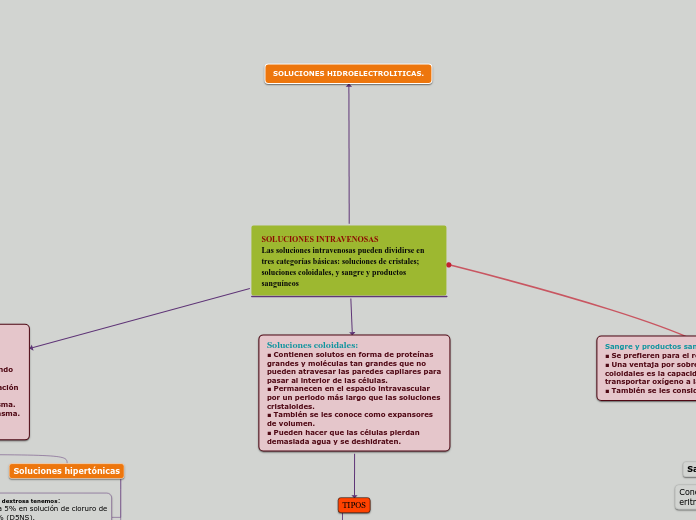Sangre y productos sanguíneos
■ Se prefieren para el reemplazo de sangre perdida.
■ Una ventaja por sobre las soluciones cristaloides y
coloidales es la capacidad de la hemoglobina para transportar oxígeno a las células.
■ También se les considera expansores de volumen.
Crioprecipitado
Plasma congelado
fresco (FFP)
Plaquetas
Concentrado de
eritrocitos (PRBC)
Sangre entera
SOLUCIONES INTRAVENOSAS Las soluciones intravenosas pueden dividirse en tres categorías básicas: soluciones de cristales; soluciones coloidales, y sangre y productos sanguíneos
Name the character
Type in the name of the character whose change throughout the story you are going to analyze.
Example: Nick Carraway.
Soluciones cristaloides:
■ Contienen agua, dextrosa, electrólitos o todas las anteriores, y suelen utilizarse para tratar múltiples desequilibrios hidricoelectrolíticos. ■ Afectan el movimiento del agua corporal, dependiendo de la concentración de electrólitos.
■ Se clasifican de acuerdo con su tonicidad (concentración deelectrólitos).
Isotónicas: misma cantidad de electrólitos que el plasma.
Hipotónicas: menor cantidad de electrólitos que el plasma.
Hipertónicas: mayor cantidad de electrólitos que el plasma.
Character's feelings
Focus on the way the character's feelings are presented at the beginning and at the end of the story, while explaining why they have changed.
Soluciones hipertónicas
Soluciones salinas hipertónicas tenemos: Solución de cloruro de sodio a 3% (NaCl
a 3%).
• Solución de cloruro de sodio a 5% (NaCla 5%).
The reason for the change of feelings
Why did the character change his feelings? Type in the answer.
Example: the East lost its appeal due to the shallowness, carelessness and corruption.
Soluciones de dextrosa tenemos:
• Dextrosa a 5% en solución de cloruro de
sodio a 0.9% (D5NS).
• Dextrosa a 5% en solución de
lactato sódico compuesta (D5LR).
The reason for the change of feelings
What caused the character to change the first belief you mentioned? Type in the reason for the change.
Example: disgust towards the lack of morality in the Buchanan family.
Soluciones hipotónicas
Solución salina hipotónica tenemos: •Solución salina a
0.225% (1/4 NS).
• Solución salina a 0.45% (1/2 NS).
Change of feelings
How did the character change the belief you mentioned?
Type in a relevant quote for his change.
Example: 'Winter night and the real snow, our snow(...)We drew in deep breaths of it . . . unutterably aware of our identity with this country for one strange hour before we melted indistinguishably into it again. That's my middle-west.' - Nick on the purity and integrity of Midwest.
Soluciones de dextrosa tenemos: Dextrosa a 5% en agua
(D5W).
• Dextrosa a 5% en solución salina a 0.225% (D5 1/4 NS).
• Dextrosa a 5% en solución salina a 0.45% (D5 1/2 NS).
Change of feelings
In what way did the character change the feeling you mentioned?
Type in a quote to support your statement.
Example: 'They are a rotten crowd. You're worth the whole damn bunch put together.' - Nick criticizing the Buchanans.
Soluciones isotónicas
Soluciones balanceadas de
electrólitos tenemos:
• Solución de cloruro de sodio
compuesta (Ringer)
• Solución de lactato sódico
compuesta (LR).
Solución salina isotónica tenemos : •Solución de cloruro de sodio
a 0.9% (solución salina
normal, NS, NaCl).
Soluciones coloidales: ■ Contienen solutos en forma de proteínas
grandes y moléculas tan grandes que no
pueden atravesar las paredes capilares para pasar al interior de las células.
■ Permanecen en el espacio intravascular por un periodo más largo que las soluciones
cristaloides.
■ También se les conoce como expansores de volumen.
■ Pueden hacer que las células pierdan demasiada agua y se deshidraten.
TIPOS
Fracción de proteína
plasmática
• Concentración a 5%.
Dextrano (polisacáridos)
• Dextrano de bajo peso
molecular (Dextrano
40).
• Dextrano de alto peso
molecular (Dextrano
70).
Initial feelings
How does the character feel about a certain subject at the beginning of the story? Type in a relevant quote to support your statement.
Example: "Reserving judgements is a matter of infinite hope."
Albúmina (proteína
plasmática humana)
• Concentraciones a 5 y
25%.
Initial feelings
What was the character's initial belief? Type in a relevant quote.
Example: 'seems like the ragged edge of the universe' - Nick talking about Midwest, the place where he grew up.
SOLUCIONES HIDROELECTROLITICAS.
Title
Type in the title and author of the literary work that introduces the character.
Example: The Great Gatsby, by F. Scott Fitzgerald.









